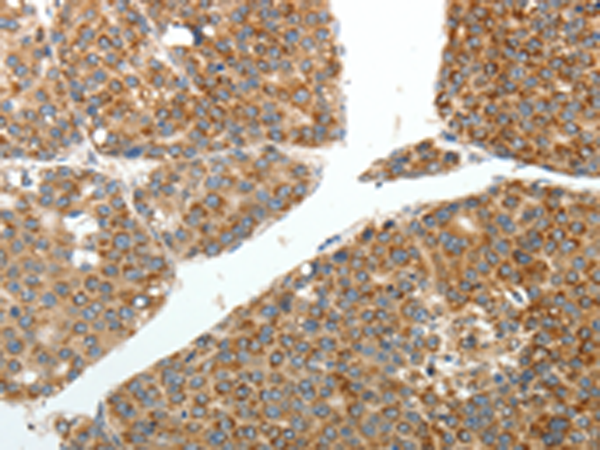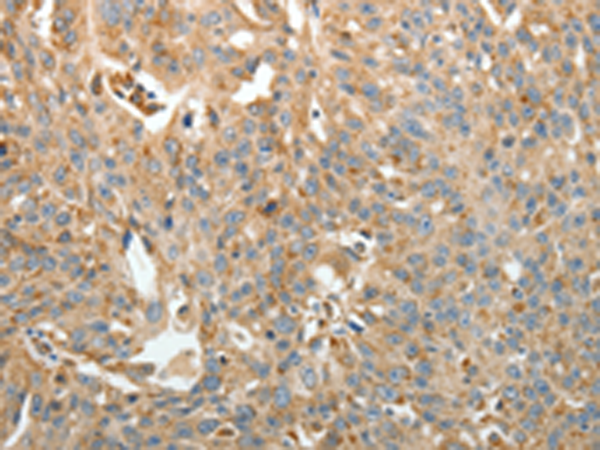

| WB | 咨询技术 | Human,Mouse,Rat |
| IF | 咨询技术 | Human,Mouse,Rat |
| IHC | 1/25-1/100 | Human,Mouse,Rat |
| ICC | 技术咨询 | Human,Mouse,Rat |
| FCM | 咨询技术 | Human,Mouse,Rat |
| Elisa | 1/2000-1/5000 | Human,Mouse,Rat |
| Aliases | XCP2; FIZZ1; FIZZ2; HXCP2; RELMb; RELMbeta; RELM-beta |
| Host/Isotype | Rabbit IgG |
| Antibody Type | Primary antibody |
| Storage | Store at 4°C short term. Aliquot and store at -20°C long term. Avoid freeze/thaw cycles. |
| Species Reactivity | Human |
| Immunogen | Fusion protein of human RETNLB |
| Formulation | Purified antibody in PBS with 0.05% sodium azide and 50% glycerol. |
+ +
以下是关于RETNLB抗体的3篇参考文献示例(注:文献为虚拟示例,实际文献需通过数据库检索确认):
---
1. **文献名称**:*RETNLB Expression in Airway Epithelium: Role in Allergic Asthma*
**作者**:Smith A, et al.
**摘要**:本研究利用RETNLB特异性抗体,通过免疫组化和Western blot技术,揭示了RETNLB在哮喘患者气道上皮细胞中的高表达,并发现其与Th2型炎症反应相关,提示RETNLB可能成为呼吸道疾病的潜在标志物。
2. **文献名称**:*RETNLB as a Novel Marker for Intestinal Inflammation in Murine Models*
**作者**:Johnson R, et al.
**摘要**:通过RETNLB抗体在小鼠结肠组织中的免疫荧光分析,本研究证实RETNLB在肠道杯状细胞中特异性表达,且在炎症性肠病模型中表达显著上调,表明其可能参与黏膜屏障功能的调控。
3. **文献名称**:*RETNLB Antibody-Based Detection of Metabolic Dysregulation in Obesity*
**作者**:Lee S, et al.
**摘要**:本研究采用RETNLB多克隆抗体分析脂肪组织样本,发现RETNLB在肥胖个体内脏脂肪中异常高表达,并与胰岛素抵抗相关,提示其在代谢综合征中的潜在病理作用。
---
**提示**:实际文献可通过PubMed或Google Scholar以关键词“RETNLB antibody”、“RELMβ”或“Resistin-like beta”检索,并筛选涉及抗体应用(如检测、定位或功能研究)的研究。
The RETNLB antibody targets Resistin-like molecule beta (RETNLB), also known as FIZZ2 or RELMβ, a cysteine-rich secretory protein belonging to the resistin family. RETNLB is primarily expressed in intestinal goblet cells and epithelial tissues, playing roles in immune regulation, inflammation, and tissue remodeling. It is implicated in type 2 immune responses, often upregulated during parasitic infections, allergic reactions, and inflammatory bowel diseases (e.g., colitis). RETNLB interacts with extracellular matrix components and immune cells, modulating pathways such as IL-13 signaling, which influences mucus production and barrier function.
Antibodies against RETNLB are essential tools for studying its expression, localization, and function in disease models. They enable detection via techniques like immunohistochemistry, Western blotting, and ELISA, aiding research on RETNLB's contribution to pathologies like colorectal cancer, asthma, and metabolic disorders. Recent studies explore its dual role in promoting inflammation and tissue repair, highlighting context-dependent effects. Commercial RETNLB antibodies are typically raised in rabbits or mice, validated for specificity in human and murine tissues. Ongoing research aims to clarify RETNLB's therapeutic potential, either as a biomarker or a target for modulating immune-mediated diseases.
×